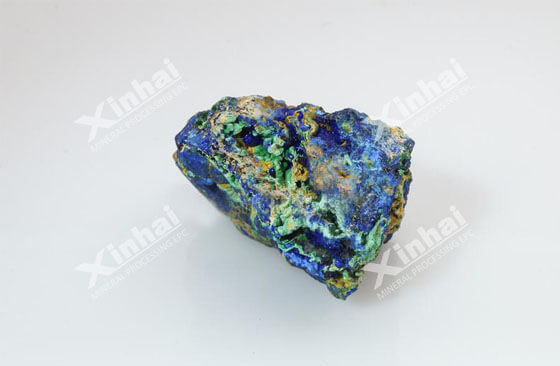

Warm Tip: If you want to know more details about equipment, solutions, etc, please click the button below for free consultation, or leave your requirements!
With the continuous acceleration of the industrialization process, social development has an increasing demand for metallic copper. However, with the deepening of mining, high-quality and high-purity copper ore and copper sulfide are gradually depleted, and it is difficult to meet the needs of social development. And most of the copper deposits have oxidation zones, and most of them have formed independent large and medium-sized copper oxide deposits. For this reason, the development and utilization of copper oxide ore is of great significance.This article mainly introduces the two main methods in copper oxide flotation: direct flotation and sulfide flotation.

blue-green copper oxide
Froth flotation is a method of separating ores using the difference in physical and chemical properties of mineral surfaces. It is currently the main method for the flotation of copper oxide. Relatively speaking, froth flotation can be used to separate malachite and azurite. However, chrysocolla and copper phosphate are difficult to float. According to the nature of the reagents used in flotation and the nature of the copper oxide itself, the flotation of copper oxide ore can be divided into two types, namely direct flotation and sulfide flotation.
just as its name implies, direct flotation is a method of flotation using collectors directly to flotate copper oxide,which is mainly for copper oxide with relatively simple mineral properties and simple structure, where the performance of the collectors is a direct factor affecting its flotation efficiency and quality.
According to the corresponding collectors, the direct flotation method can be divided into the following categories.
(1)Fatty acid: Used in the early stage of copper oxide flotation, mostly using fatty acid salts as a collector, with significant effect. The cost is low, but only for malachite or ore with high grades.
(2)Amine: Amine collector can also be a cationic collector, is a more commonly used collect in non-ferrous oxide ore flotation, has a strong collecting ability for copper oxide, mainly used with malachite and azurite ore and other copper oxide, especially deposits containing copper and zinc.
(3)Chelated collector: Chelating agents are characterized by their extreme selectivity in copper oxide flotation, which can be selectively adsorbed on all minerals containing a certain element and are not easily affected by nature of these minerals, forming stable chelates with metal ions. Therefore, with the use of an integrated collector, you can obtain a high selectivity and collecting effect.
(4)Phosphoric acid: This type of collector is mainly based on phosphate and dimethyl hypophosphorous acid in copper oxide flotation. According to the research data, Dimethyl hypophosphorous acid is very effective in the flotation of muddied fine-grained refractory malachite.
Sulfide flotation is the main method for copper oxide flotation at home and abroad. Copper oxide, mainly malachite, azurite, and cuprite, can obtain a better flotation index.
Sulfide flotation is the process of sulfiding the ground copper oxide slurry by adding the appropriate sulfiding agent, followed by the addition of sodium sulfide, sodium hydrosulfide, and other collectors for copper oxide flotation. After sulfidation, a copper sulfide film is formed on the surface of the copper oxide, giving it the surface properties of copper sulfide, and then flotation will be performed using collectors. Therefore. The sulfidation process is directly related to the quality and efficiency of copper oxide flotation.
Under normal circumstances, it is necessary to control the concentration of sodium sulfide to control the degree and speed of sulfidation of the copper oxide pulp. Relevant practical data show that when the pH value of the medium is between 7-10, that is, when it is alkaline, the recovery rate is the highest. However, if the concentration of sodium sulfide is too high or the pH value is too high, there will be an inhibiting effect and the minerals will be inhibited, with little adsorption and a low recovery rate. Therefore, during the sulfidation process, it is necessary to maintain attention to the pH value of the medium, adjust its pH value and the concentration of injected sodium sulfide at any time to effectively improve the copper oxide flotation efficiency.
The above are the 2 methods for copper oxide flotation. To alleviate the contradiction between the supply and demand of copper resources, it is very important to strengthen the mining and utilization of low-grade copper oxide. However, the specific copper oxide flotation process used needs to be determined according to the actual concentrator situation and the nature of the ore. Therefore, it is recommended that mine owners choose copper oxide flotation process and copper oxide processing equipment to consult with equipment manufacturers with the overall plant qualification, select the process suitable for the nature of ore, and fundamentally guarantee the production efficiency and economic efficiency of the entire processing plant.
If you have any questions about copper oxide flotation or need more details, please contact our online customer service or leave a message below, we'll contact you as soon as possible.
Last: 4 Q&A You Need to Know About Froth Flotation Process
Next: How to Improve the Leaching Rate of Gold Heap Leaching
1What Are the Processes and Equipment Used in the Copper Mining Process?

 4816
4816


What Are the Differences Between CIP and CIL?
 11212
11212
 0
0